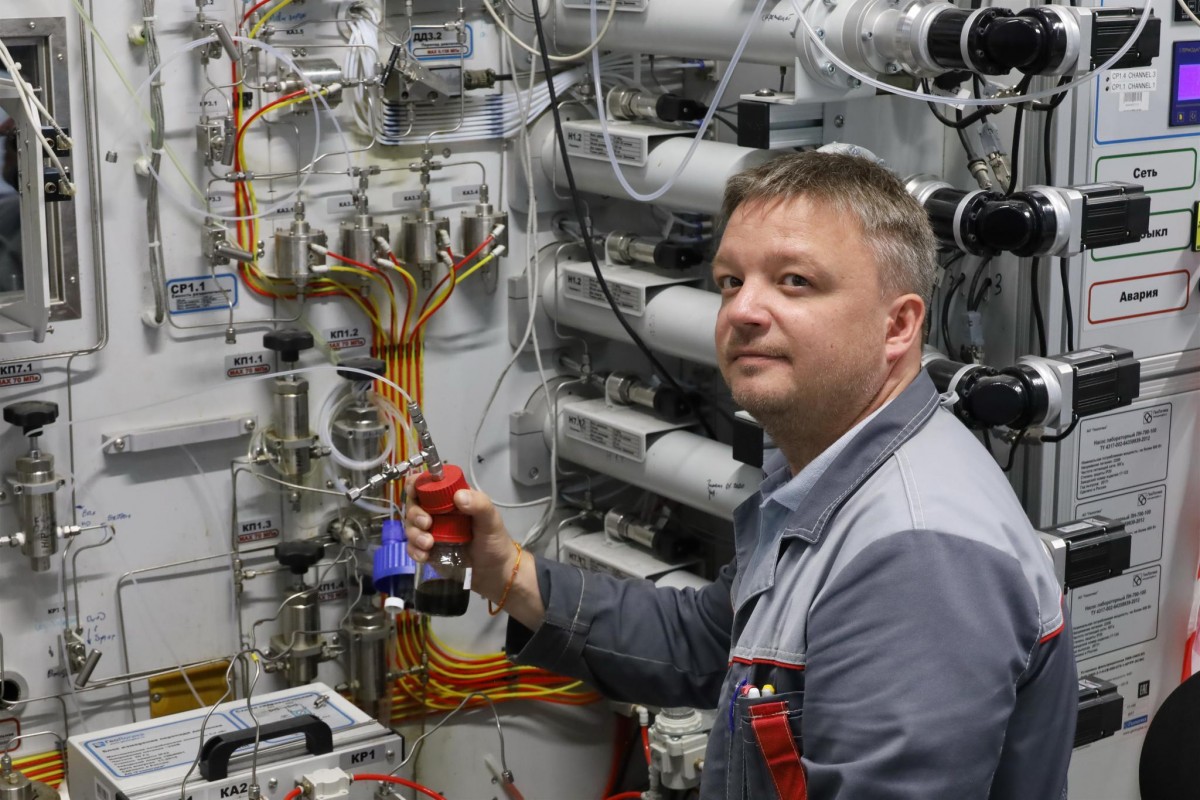
Photo. Denis Bakulin of Skoltech Petroleum, one of the authors of the study. He oversaw the filtration experiment, intended to reveal the effect of chemical injection on oil recovery. Credit: Denis Bakulin/Skoltech
Skoltech researchers have studied the effect of injecting two chemical agents for enhanced oil recovery into oil shale. As it turned out, both of the investigated fluids — water solutions of nanoparticles and a soaplike substance called a surfactant — are not feasible options for shale oil projects. In fact, these agents may trap the oil underground instead of helping it to be recovered. Bearing that risk in mind, the performance of other agents should now be explored, the scientists suggest. Their findings are reported in Energy & Fuels.
Over the lifetime of an oil well, the underground pressure forcing the oil to the surface gradually drops. At some point, further extraction is only feasible if so-called enhanced oil recovery techniques are used — these involve injecting steam, chemicals, and other agents into the reservoir. For shale deposits, which are harder to extract from, enhanced recovery is often a necessity to begin with.
Enhanced recovery encompasses three main approaches: Thermal injection relies on preheated water, air, etc. to heat the oil within the reservoir, making it less viscous and more mobile. Gas injection expands the oil and makes it more mobile by mixing it with carbon dioxide, natural gas, etc. Finally, chemical injection is an umbrella term for a number of techniques that use various water-based fluids with diverse mechanisms of action to boost oil recovery.
Oil shale is a lucrative source of hydrocarbons that allows countries and companies to tap into previously unavailable resources. However, the effects of enhanced oil recovery techniques tried and tested on conventional deposits are poorly understood when they are applied to shale reservoirs. Finding out what works and what doesn’t is a key to unlocking this valuable resource.
A research team from Skoltech Petroleum featuring Junior Research Scientist Alexandra Scerbacova and Senior Research Scientist Elena Mukhina — the lead authors of the study — and the project’s principal investigator Alexey Cheremisin ran a numerical simulation and two complex and unique lab experiments on oil shale samples to determine if it is feasible to inject water solutions containing silicon dioxide nanoparticles or a soaplike substance called a surfactant into shale oil reservoirs to enhance recovery.
“Our study considered 13 fluids and two were selected for tests on cylinder-shaped samples of oil-saturated rock from the Bazhenov Formation of Western Siberia,” Alexandra Scerbacova commented. “First we injected brine — water with a very high salt content — and measured an oil recovery factor of about 53%. This is roughly analogous to being able to extract about half of the oil in the reservoir. That figure served as the baseline value for assessing the efficiency of the two agents in the experiment, although the value under actual reservoir conditions would be lower.”
The surfactant chosen by the researchers is technically known as sodium fatty acid methyl ester sulfonate. While it did boost the oil recovery factor, the resulting value came out at 53%, same as with brine injection, so this particular agent is clearly not economically viable, since it costs way more than the readily available water.
In addition to the test on an actual rock sample, surfactant injection was also numerically simulated. But while the simulation accurately predicted the oil recovery factor, it failed to account for the adverse effect observed in the experiment: Some of the pores in the rock got blocked, reducing its permeability. This highlights the importance of experimental studies.
With the other, nanoparticle-based agent, the problem of decreased rock permeability proved even more acute, as the experiment demonstrated. “Due to the small size of rock pores and channels which do not exceed the size of nanoparticles … the filtration of nanofluids may eventually lead to critical damage to the shale rock,” the study warns.
“We have shown that water or surfactant injection, a relatively cheap and effective enhanced oil recovery technique for conventional reservoirs, is not as appealing as it seems and bears considerable risks when it comes to oil shales in general and the Bazhenov Formation in particular. Further research is necessary to identify alternative surfactants and other enhanced oil recovery techniques — perhaps, gas injection — that might prove suitable for shale oil reservoirs,” Elena Mukhina concluded.
This research is part of a long-term project of Skoltech and Gazpromneft. The study was supported by the Ministry of Science and Higher Education of the Russian Federation under agreement No. 075-10-2022-011.
Contact information:
Skoltech Communications
+7 (495) 280 14 81
